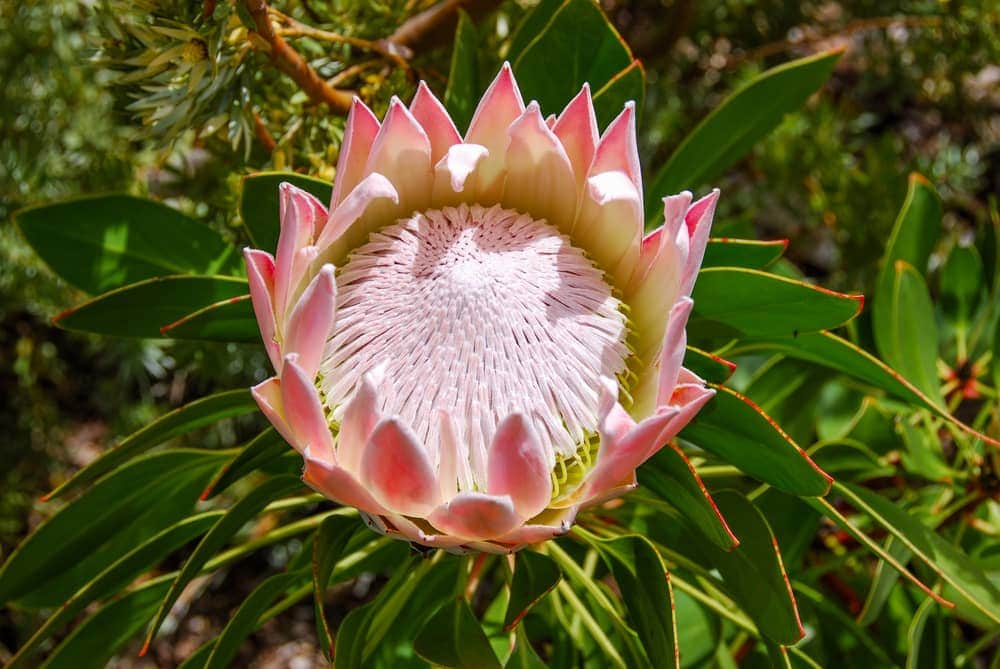Bold, dramatic, and eye-catching — say hello to the protea!
Proteas make excellent garden plants with their one-of-a-kind flowers and attractive, leathery green leaves.
Best of all, they’re easy to grow, thriving in the same conditions as Aussie natives.
Give them plenty of sun and well-drained soil, and proteas will reward you with colourful blooms for much of the year.
Here’s everything you need to know about growing proteas in Australia.
Varieties | When to Plant | Growing Conditions | Where to Plant | How to Grow | Protea Care | Propagation | Common Problems
All About the Protea Plant
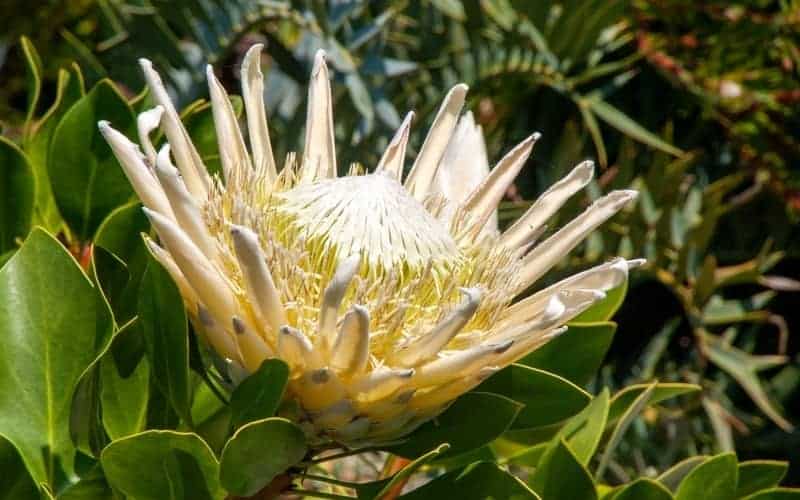
Proteas are hardy evergreen shrubs known for their exotic-looking flowers. Many describe them as alien-like!
Different protea varieties offer a unique look. One thing all proteas share, though, is their distinct flower head.
It’s made up of many small flowers surrounded by colourful, stiff bracts (or modified leaves).
These showy bracts give protea flowers a spectacular goblet-like shape.
They come in a wide range of colours, too — pink, red, white, yellow, and orange.
Proteas’ leaves are usually green, leathery, and lance-shaped, growing in a spiral pattern along the stems.
How big do proteas grow?
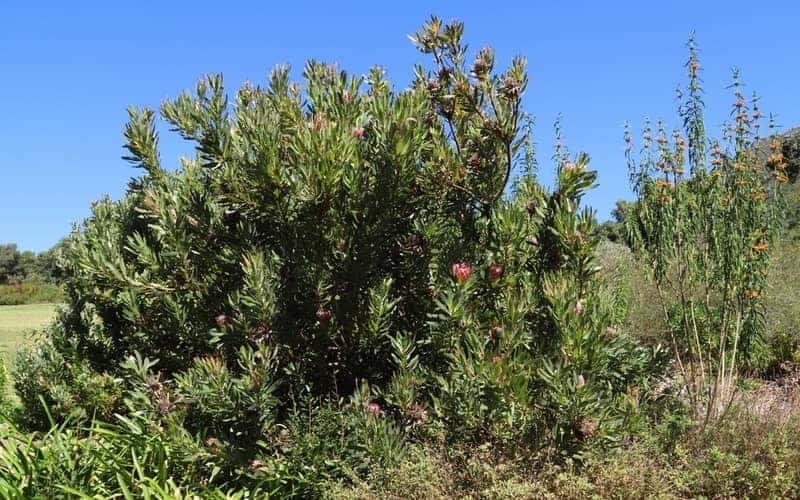
Protea plants typically reach 1–3m tall and wide, but their mature size can vary depending on the species.
Dwarf proteas are more compact. They usually stay between 1 and 1.5m, making them ideal for smaller gardens or pots.
When do proteas flower in Australia?
Proteas offer year-round colour, blooming from late summer to the following spring.
However, flowering times may differ slightly depending on the species and the local climate.
When cut, the flowers can last up to 2 weeks.
And because they’re long-lasting, they’re often used in floral displays like bouquets and vase arrangements.
Is the protea native to Australia?
It’s a common assumption, but proteas are not Australian natives. They actually originated in South Africa.
Proteas do look similar to native plants such as banksias, grevilleas, and waratahs — but that’s because they all belong to the Proteaceae family!
Common Protea Varieties
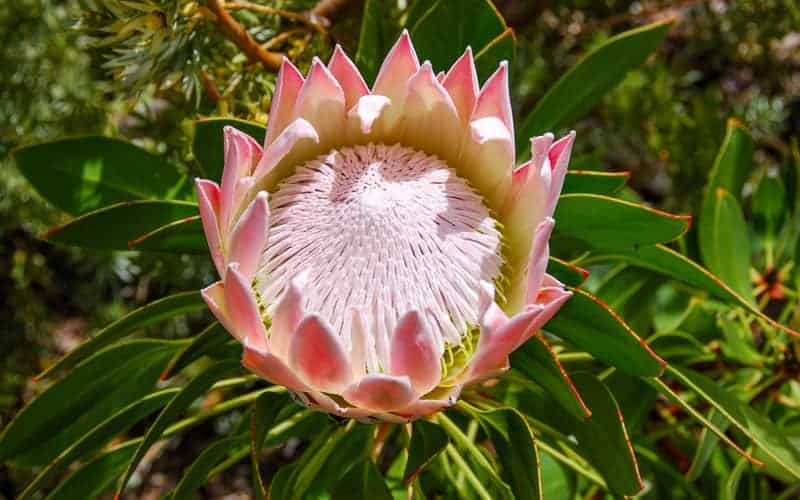
There are over 100 species of proteas, with different colours, shapes, and sizes. In Australia, common protea varieties include:
Protea cynaroides (King Protea): Has large, artichoke-like flowers, usually pink or white
Protea compacta (Bot River): Has goblet-like flower heads in shades of pink and red
Protea repens (Common Sugarbush): Features cup-shaped, nectar-rich flowers that could be red, pink, or white
When to Plant Proteas in Australia
The best time to plant proteas in Australia is in late autumn or early spring, when the weather is cooler.
This gives them enough time to establish before the summer heat arrives.
Protea Growing Conditions
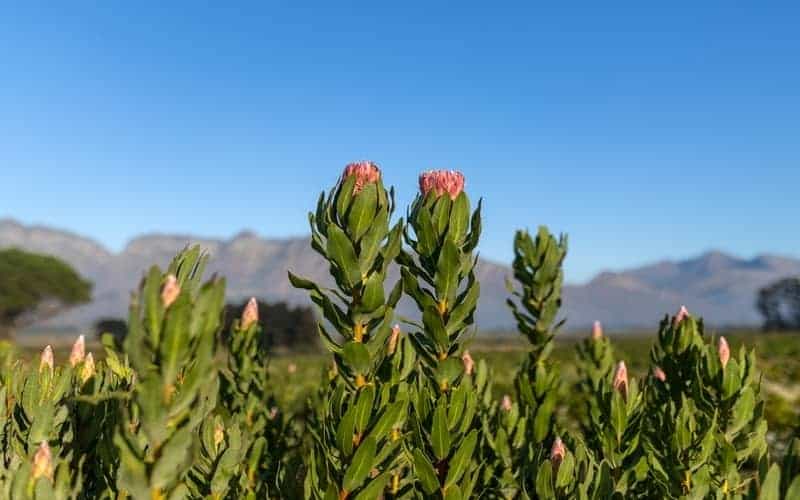
Proteas grow in the same conditions as Australian native plants in the Proteaceae family.
They flourish in mild climates, full sun, and well-drained soil.
Climate
Proteas thrive in mild, Mediterranean climates with cool, wet winters and warm, dry summers.
Temperatures between 4°C and 35°C are optimal, but established proteas are also frost tolerant.
Mature plants can usually handle low temperatures down to −4°C, although some varieties are more cold-hardy.
On the other hand, young plants need to be sheltered from prolonged snow.
Light
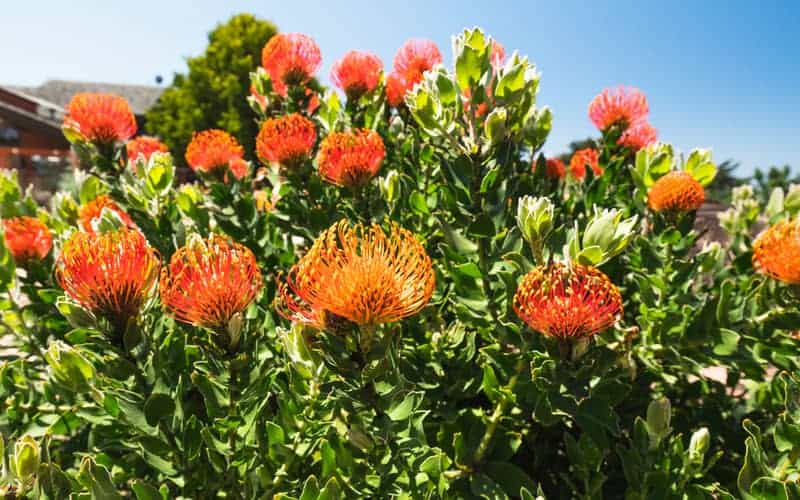
Proteas love sunlight — they need a lot of it to produce healthy blooms with vibrant colours!
Grow proteas in a spot where they can get at least 6 hours of full sun per day.
Too much shade can lead to fewer or pale-looking blooms.
Soil
Proteas prefer slightly acidic (pH of 5.5–6.5), free-draining soil.
Sandy loam is ideal, but they can also thrive in coastal sands and rocky ground.
Avoid using heavy clay soils, as these retain too much moisture.
Moreover, proteas are adapted to low-nutrient conditions. Do not grow them in overly rich soils, which can lead to leggy growth.
High phosphorus levels are also toxic to proteas. Steer clear of areas where phosphorus-rich fertilisers have been used.
Before planting, test your soil to determine its pH and nutrient levels.
Soil test kits are available at most garden centres — follow the instructions carefully for accurate results.
Where to Grow the Protea Plant
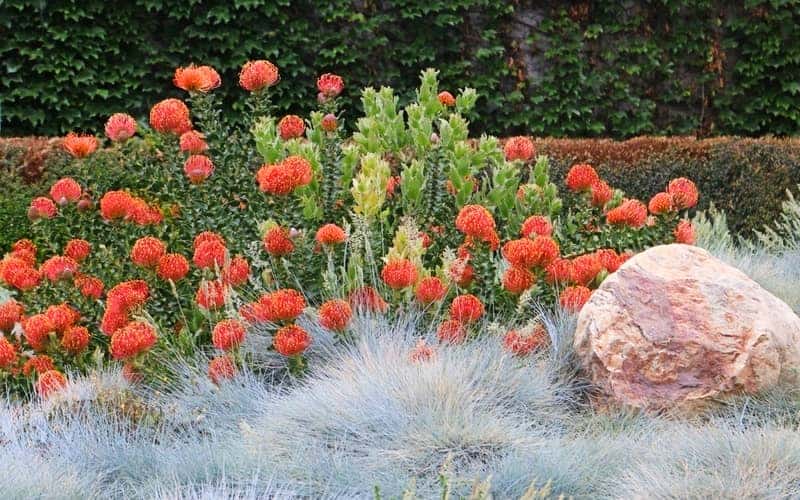
Proteas are very versatile — you can grow them in garden beds or in pots!
No matter where you plant them, be sure to pick a sunny position with good air circulation.
This helps them produce many bright blooms and prevents fungal issues.
Growing proteas in garden beds
Garden beds are ideal for proteas because they improve drainage, which is a must for healthy roots.
Planting directly in the ground also lets you incorporate proteas into your landscape.
Proteas are excellent as feature plants or for creating dense privacy hedges and screens.
Growing proteas in pots
Potted proteas are perfect for balconies, patios, and even bright indoor spaces.
For indoor growing, opt for smaller types like the ‘Little Prince’ Protea, which reaches just about 1m tall.
Place the plant by a sunny window, and rotate it regularly for even light exposure.
However, keep in mind that proteas grown inside may not flower as much as those grown outdoors!
Consider using grow lights if natural light is limited and during colder months.
The pot size matters, too. Choose a slightly larger pot, about 5–8cm wider than the nursery container.
Make sure the pot has lots of holes at the bottom. You can also elevate it with pot feet to improve drainage.
Moreover, use a coarse, well-drained potting mix suitable for native plants.
As your protea grows, repot it every year into a slightly larger container. Handle it with care, as the roots are sensitive.
How To Grow Proteas
The most reliable way to grow proteas is to start with a young plant from a local nursery.
If you’re unsure where to begin, chat with a gardening professional in your area.
They can help you pick the right variety and even take care of the planting for you!
Preparing the soil for proteas
Proteas require slightly acidic, well-draining soil with low phosphorus levels.
After testing your soil’s pH and nutrient content, you may need to amend it.
FOR ALKALINE SOIL: Make the soil acidic for proteas by adding sulphur or peat moss. After amending, retest the soil to see if the pH has dropped to 5.5–6.5.
FOR HIGH-PHOSPHORUS SOIL: Plant proteas in a raised garden bed about 45cm high. Use a low-phosphorus, well-draining mix with coarse sand and pine bark fines.
FOR HEAVY CLAY SOIL: Create a raised bed 30–45cm high using a free-draining garden mix.
Planting a protea
To get started, dig a hole twice as wide as the nursery pot and the same depth as the protea’s root ball.
The extra width gives the roots room to spread.
If the roots are tightly wound, gently tease them apart to encourage them to grow outwards.
Be careful, as proteas have very sensitive roots!
Next, lower your protea into the centre of the hole. Keep the top part of the roots close to or just above the soil surface.
Backfill the hole, and lightly firm the soil around the base. Do not press too hard to keep the soil loose and maintain good drainage.
Once planted, water your new protea deeply to help settle the soil.
Finally, mulch around the base but away from the main stem. This helps retain moisture while preventing root rot.
Caring for Protea Plants
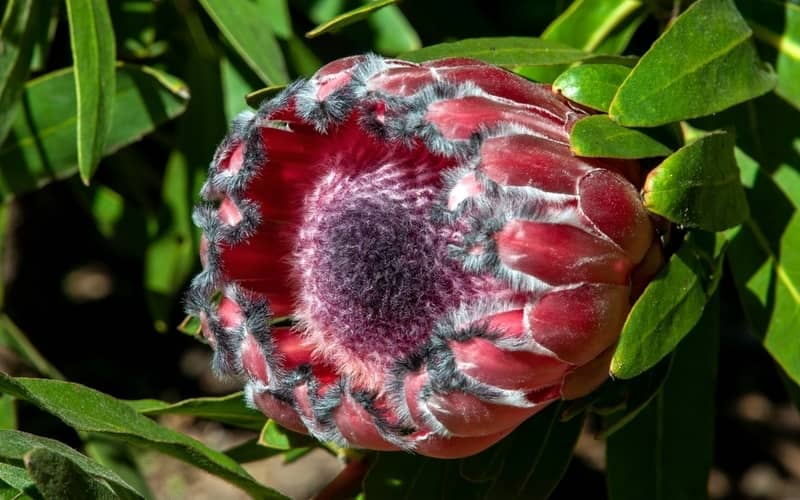
The hardy, low-maintenance protea is great for the forgetful gardener!
It’s adaptable, tolerates dry conditions, and needs minimal pruning.
Watering
During the first 12–18 months after planting, water your protea regularly to help it establish.
Keep the soil moist but never soggy by letting it dry out slightly between waterings.
To check if it’s time to water, insert a stick into the top 5–10cm of soil. If it comes out clean, go ahead and water.
Once established, proteas are drought-tolerant. You’ll only need to water them during long dry periods.
Always water at the base of the plant to keep the leaves dry and prevent fungal problems.
Fertilising
Proteas don’t need much fertiliser, as they do just fine in poor soils.
For overall health, you can use a seaweed tonic like Seasol, which has low levels of nitrogen, phosphorus, and potassium.
Only fertilise your protea if you see signs of nutrient deficiency, such as yellowing between leaf veins and weak stems.
Use a slow-release fertiliser suitable for native plants, with low or zero phosphorus.
Apply at least once a year, preferably in late winter.
Do not use high-phosphorus fertilisers, as this can harm proteas!
Pruning
For young protea plants, trim off the stem tips in spring or late summer. Pinch off the terminal buds to encourage bushy growth.
Once established, prune your proteas after flowering. Cut spent flowers 10–15cm above where the stem meets healthy leafy growth.
This redirects the plant’s energy into producing blooms for the next season.
Always leave several green leaves below the cut, and never prune stems into bare wood! This allows new shoots to form later on.
To shape overgrown proteas, trim overly long or awkward stems to maintain a neat and compact bush.
If the plant has been neglected, you can prune it further, but don’t remove more than 50% of the foliage!
How to Propagate Proteas
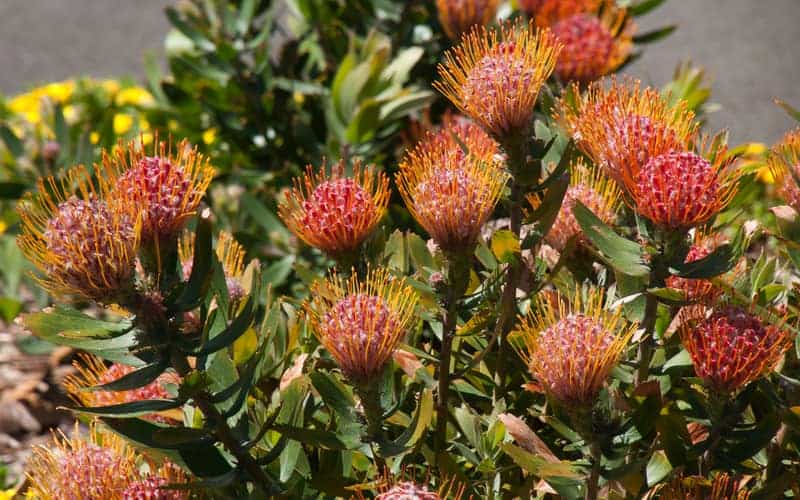
You can propagate proteas from stem cuttings or store-bought seeds.
Propagating proteas from cuttings
To start, choose a healthy, semi-hardened branch. Cut about 15cm from the tip, then trim off the top portion.
Next, remove the leaves from the bottom half, leaving 3–5 at the top.
Make a slanted cut at the base, then dip the cut end into a rooting hormone for a few seconds.
In a small pot, prepare a propagation mix made of 2 parts coarse sand, 1 part peat moss, and 1 part perlite.
Stick the bottom half of the cutting into this mix, then place it in a warm spot away from direct sunlight.
Mist the cutting a few times a day to keep it moist. In 2–3 months, roots should start to form.
Once the roots are strong, transplant the protea cutting into well-drained soil.
Propagating proteas from seeds
Make sure you buy protea seeds from a reputable supplier.
Once you have the seeds, soak them in room-temperature water for 24 hours.
Add smoke-water, since protea seeds need chemicals from smoke to germinate. Be sure to follow the instructions on the bottle.
After soaking, let the seeds dry on a paper towel.
Then, fill a tray with a mix of 2 parts coarse sand, 1 part peat moss, and 1 part perlite. Mist it lightly so it’s moist.
Place each seed on top of the soil, keeping them 2–3cm apart. Afterwards, sprinkle a thin layer of the soil mix over them, then mist again.
Keep the tray in a warm spot with bright, indirect light. Keep the soil slightly moist but not wet.
Seeds can take anywhere from 3 weeks to 3 months to sprout, so be patient! When the seedlings reach about 5–10cm tall, you can pot them individually.
Common Protea Plant Problems
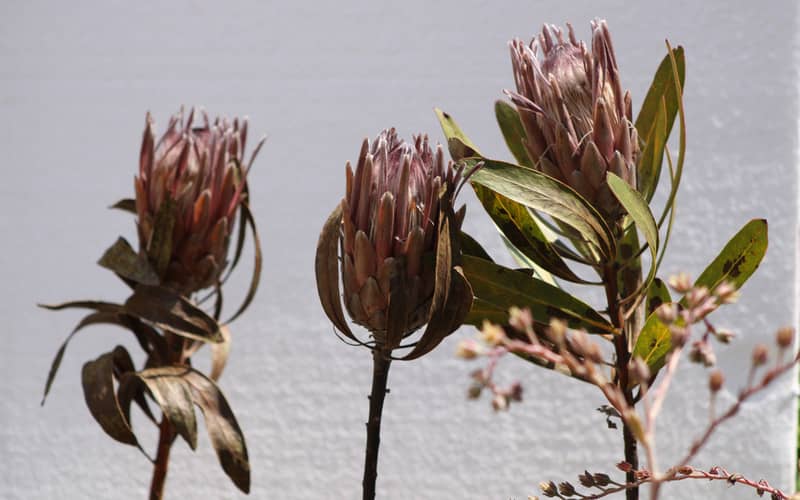
Proteas are tough, but they can face a few problems if they’re not grown in the right conditions.
Pests like aphids, scale insects, spider mites, and thrips can attack proteas.
Isolate affected plants ASAP. Then treat them with a solution of ½ tbsp of neem oil, 1L of water, and a few drops of dish soap.
Fungal diseases such as leaf spots and stem cankers are more common during rainy periods.
Prune off any affected areas immediately. Then, spray the entire plant weekly with a neem oil solution.
Root rot is another risk, especially in poorly draining soil.
If the protea’s leaves are browning and dying, carefully dig around the base of the plant to check the roots.
Mushy, foul-smelling, and dark roots indicate rot. When this happens, stop watering and consult a specialist immediately.
Watch out for phosphorus toxicity, too. Signs include yellowing leaves with brown or black tips.
If these symptoms appear, stop fertilising your proteas and seek advice from an expert.
FAQs: More About Proteas
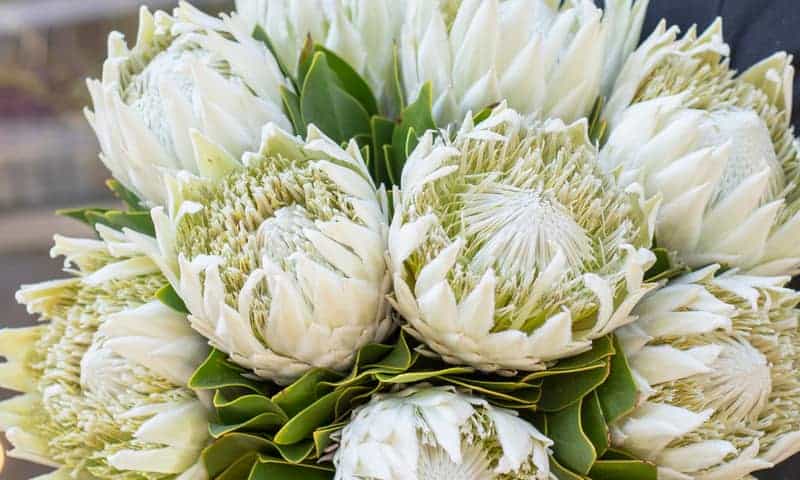
Discover more about the magnificent protea!
How fast do proteas grow?
In ideal conditions, proteas can put on 30–60cm of height per year, especially while they’re young.
These shrubs are considered moderately fast-growing plants.
Are protea roots sensitive?
Yes, proteas have a shallow root system that’s highly sensitive.
Because their roots grow close to the soil surface, they’re easily disturbed by digging or heavy foot traffic.
Aggressive root disturbance can stress the plant and even cause its death.
What can I plant with proteas?
Good companion plants for proteas include Australian natives from the Proteaceae family, like banksias and grevilleas.
Proteas also pair well with Leucadendron species.
These plants share similar growing needs and are drought-tolerant, making them ideal for low-maintenance gardens.

